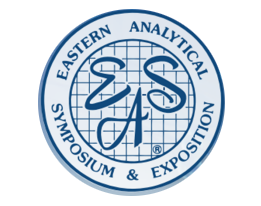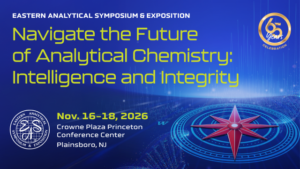Principles of Trace Level Structure Elucidation:
High Sensitivity MS and NMR
E14-03, Two-Day Course
Sunday, November 16 – Monday, November 17, 8:30am-5:00pm
Dr. Daniel L. Norwood, Boehringer Ingelheim Pharmaceuticals, Ridgefield, CT
Dr. Nina C. Gonnella, Boehringer Ingelheim Pharmaceuticals, Ridgefield, CT
COURSE DESCRIPTION
The purpose of this course is to provide an understanding of trace level structure elucidation of organic molecules based on Mass Spectrometry (MS) and Nuclear Magnetic Resonance (NMR) spectroscopy. An overview of MS and NMR instrumentation along with relevant concepts of fundamental theory will be presented. Concepts of ionization, mass analysis, molecular ion formation and fragmentation will be presented for MS. The NMR session will cover basic theory and spectral interpretation, incorporating J-coupling, spin relaxation and the nuclear Overhauser effect (NOE). A systematic process for trace level structural analysis along with a philosophy of structure elucidation problem solving will be presented and discussed. Mass spectrometry data elements and experiments will be covered as well as NMR experiments essential to structural analysis of small molecules, In particular the NMR section will provide instruction in the analysis of 1H and 13C 1D and 2D NMR experiments required for full structure characterization. Applications relevant to environmental, pharmaceutical, forensic and biomedical analysis will be included.
WHO SHOULD ATTEND
This course will benefit analysts, scientists, researchers, and managers who either work in or need to understand Trace Analysis and the elucidation of chemical structures. The course is designed for beginners as well as more experienced scientists familiar with the technology. Beginners will receive a fundamental introduction to the theory and practice of Trace Analysis with emphasis on MS and NMR based structural analysis problem solving. Those experienced with MS and NMR will benefit by learning systematic approaches to data acquisition and interpretation of data, and problem solving applications relevant to the environmental, pharmaceutical, forensic and biomedical fields.
TOPICS
| DAY 1: Mass Spectrometry Based Trace Organic Analysis 1. Introduction * What is Trace Organic Analysis? * A systematic process for trace level structural analysis based on mass spectrometry 2. Fundamentals of Mass Spectrometry * Instrumentation, ionization processes and mass analyzers * Mass spectrometry data elements * A new definition of “sensitivity” 3. Mass Spectrometry Interfaced to Chromatography * GC/MS * LC/MS * Surface analysis by mass spectrometry 4. Interpretation of mass spectra * Molecular weight determination * Mechanism based fragmentation * Structures of fragment ions * Solution and gas phase ion chemistry (H/D exchange; negative ion attachment) 5. Impurity Isolation and Enrichment * Extraction (partitioning; solid-phase) * Chromatographic isolation 6. Examples and Problem Solving Applications * Environmental * Pharmaceutical * Forensic * Biomedical |
DAY 2: NMR Fundamentals, Spectral Interpretation and Applications to Trace Analysis 1. Introduction * Historical Perspective 2. Instrumentation * Magnets/RF/Probes/Peripherals 3. Fundamentals of NMR in Structure Elucidation * Magnetic properties of nuclei * The Chemical Shift (electronc shielding and deshielding effects) * The Nuclear Overhauser Effect * Spin Coupling (Karplus) * Relaxation of nuclei (T1) and (T2) and Integration * Essentials of Data interpretation 4. A Strategic Approach to Spectral Interpretation * How to approach a problem * Solvent selection * Amount of sample * Use and Analysis of Multipulse NMR experiments – DEPT experiment – Homonuclear Correlated Xpectroscopy (COSY ,TOCSY, NOESY, ROESY) – Heteronuclear Correlated spectroscopy (HMBC, HMQC, HSQC) – When to use Solvent Suppression – When to use LC-SPE-NMR – Importance of Mass Spectrometry and chemical reaction schemes 5. Applications * Basic NMR interpretation of small molecules (work through several test examples) * Trace analysis by NMR * qNMR * Complementarity of solution NMR and solid state NMR |
ABOUT THE INSTRUCTORS
Dr. Daniel L. Norwood is Distinguished Research Fellow in Analytical Development US for Boehringer Ingelheim Pharmaceuticals, Inc., and leads their Structural Analysis Section. He received his Ph.D. in Environmental Chemistry from the University of North Carolina at Chapel Hill and has held senior pharmaceutical industry positions at Magellan Laboratories, Inc. and the Glaxo Research Institute. He was Medical Research Assistant Professor at Duke University Medical Center and has held an appointment as Adjunct Assistant Professor at the University of North Carolina. He chaired the PQRI (Product Quality Research Institute) Working Group on Leachables and Extractables in Orally Inhaled and Nasal Drug Products, and is currently a member of the PQRI Working Group on Leachables and Extractables in Parenteral and Ophthalmic Drug Products. He was a founding member on the Board of Directors of ELSIE (The Extractables Leachables Safety Information Exchange), and serves on the Governing Board of the Eastern Analytical Symposium. He also serves on the USP Packaging, Storage and Distribution Expert Committee and chairs their subcommittee on extractables and leachables. Dr. Norwood has over 90 publications in environmental, geochemical, biomedical and pharmaceutical analysis, and pharmaceutical regulatory science.
Dr. Nina C. Gonnella is a Senior Research Fellow at Boehringer Ingelheim. She heads the NMR group (consisting of solution, solid state and LC-NMR capability) as well as sharing co-responsibility for the Single Crystal X-ray facility. Her prior experience includes Ciba-Geigy/Novartis where she managed an NMR group in areas that included, small molecule characterization, protein-ligand structure elucidation and in-vivo drug metabolism. Nina held a position as adjunct professor at the University of Medicine & Dentistry of NJ (UMDNJ) (Graduate Program) where she participated in a graduate lecture series on structure based drug design. She subsequently joined Abbott Laboratories (Worcester Massachusetts) as a Group Leader of an NMR-LCMS group with focus on elucidating chemical structures and conducting protein-ligand binding studies. She has served on scientific review boards including an NIH Grant Review Committee as a primary reviewer. She has authored and co-authored over 70 peer review journal articles, authored a book chapter, as well as a book entitled “LC-NMR: Expanding the Limits of Structure Elucidation” CRC press 2013.

